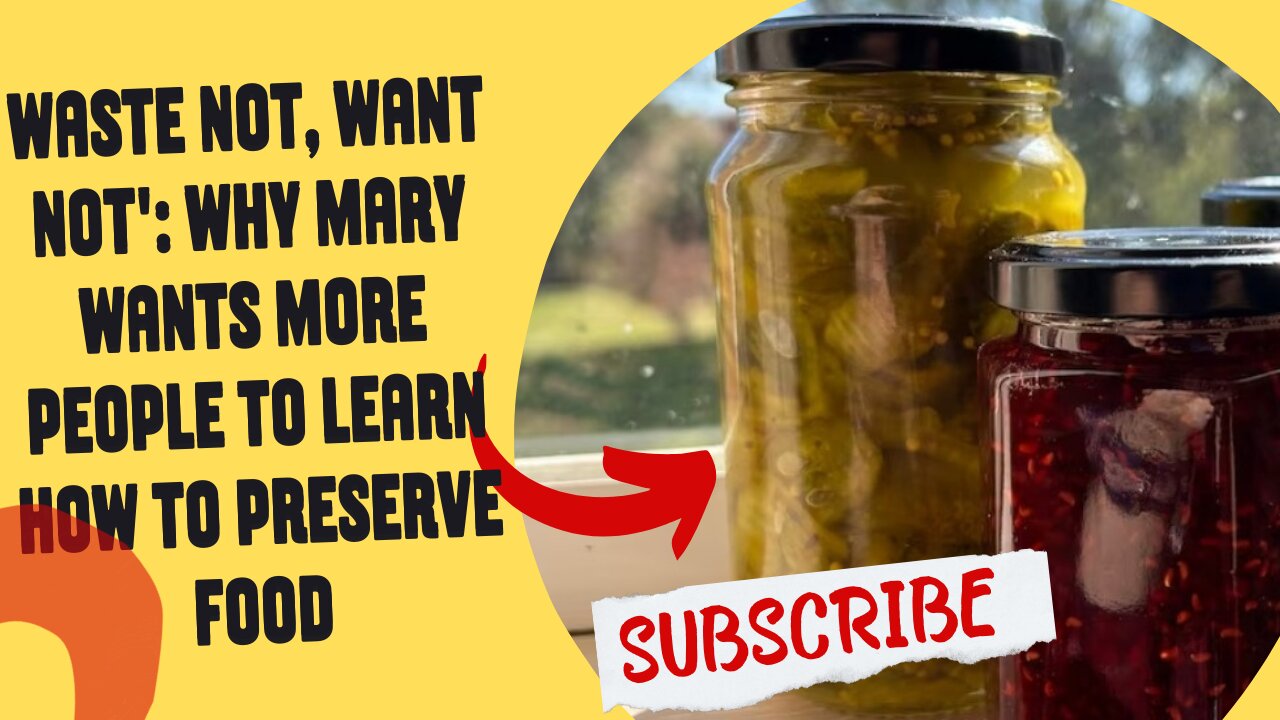Premium Only Content

Waste not, want not': Why Mary wants more people to learn how to preserve food
Waste not, want not': Why Mary wants more people to learn how to preserve food
Mary Grant has been preserving food for decades — and she learnt by watching her mother.
"We grew up on a farm and had our own orchard and our own vegetables," she says.
"I probably followed in my mother's footsteps, because she did it right up until her preserving pan got a hole in it … and she was well and truly into her 80s by then."
Mary lives in Tallangatta, a picturesque town in north-east Victoria, and has been part of the local Country Women's Association branch for 55 years.
The retired home economics teacher is a familiar face at weekly markets, where her colourful jams, jellies, relishes and chutneys often sell out.
"My mother used to always say 'waste not, want not'," she says.
"It was a mantra that I was brought up with, and that's why in this day and age, I'm really conscious of what we're wasting and the awful amount of stuff we actually throw away."
How does preserving work?
Dr Randy Adjonu is the head of food science and nutrition at Charles Sturt University in Wagga Wagga, on Wiradjuri Country.
He says ordinary ingredients like salt and sugar are key to the preserving process.
We know foods by nature start to spoil when we take them from the farm, so the whole idea of preserving is understanding how it happens or the agents that can make the food deteriorate," he explains.
"Changing the levels of sugar or salt in food simply means the environment is no longer good for microorganisms to grow."
For example, you can turn strawberries into a lovely jam with the help of sugar and lemon juice.
Salt can be used to preserve cucumbers, onions, turnips, lemons and other fruits and vegetables.
Another important part of the preserving process is heat, which helps to sterilise the food.
"During processing, we heat the food to a high temperature because most microorganisms die when they're exposed to extreme heat," Dr Adjonu says.
Homemade preserves make for lovely gifts
Over the years, Mary's learnt a few tricks of the trade.
"One of the secrets for preserving is [to use a] wide-open pan, because you want the evaporation to happen," she explains
Also you really need a big rolling boil, so it'll create this froth on top. My students laugh at me when I tell them this, but you will actually hear the jam talk to you when it's ready."
While preserving can be a rewarding activity in itself, there's also the added benefit of having homemade treats to share.
"I like starting off with some raw product and getting it into a bottle for somebody else to appreciate … and they make lovely gifts too," Mary says.
An age-old practice that can help tackle food waste
Dr Adjonu says the age-old practice of preserving also helps tackle our mounting food waste problem.
"Preserving agents have been used for generations and across many cultures to achieve three things: making food last longer; maintaining the quality of the food; and lastly ensuring food products are safe," he says.
"If we are unable to achieve these three outcomes, it simply means the food is going to spoil … and when the food spoils, we've created waste."
.According to OzHarvest, Australians waste an estimated 7.6 million tonnes of food each year, despite the demand for food relief increasing by 61 per cent in just the last six months.
Dr Adjonu says learning to preserve your own food is a small but sustainable step that can help reduce the food waste problem.
"Preserving is one of the strategies we can use to limit waste from the farm, to the food processor, and all the way to the home of the consumer," he says.
"We tend to think about large commercial or industrial food processing but in just doing that home level preservation, you've taken a great step in addressing food waste."
Preserving isn't as difficult as you might think
For many would-be preservers, tackling a tray of overripe tomatoes or bruised boysenberries is a daunting task.
But Mary says it's much simpler than people realise.
"If you're careful with how you sterilise the jars and you're using clean equipment, you really haven't got anything to worry about," she says.
That's because the ingredients you're using are what is going to actually be the preservative — sugar in your sweet things, and salt and vinegar in your savouries."
The beauty of learning to preserve things yourself is that you can turn even a handful of fruit and vegetables into something special.
"[You might find] fruit that's fallen onto the ground off the tree, and there's nothing wrong with it … it might have a few bruises, but if you just remove those, chop them up, and mix them with something else, you'll have a jam in next to no time," Mary says.
-
 LIVE
LIVE
Timcast
46 minutes agoGangs Order KILL ON SIGHT DHS Agents, Chicago Is A WAR ZONE
25,427 watching -
 LIVE
LIVE
Dr Disrespect
1 hour ago🔴LIVE - DR DISRESPECT - ARC RAIDERS - THE VENATOR SLAYER
1,022 watching -
 1:12:08
1:12:08
Steven Crowder
3 hours agoDeport All Illegals | Change My Mind
100K326 -
 DVR
DVR
The Rubin Report
1 hour agoWatch Bill O’Reilly Destroy Bill Maher’s Narrative w/ Facts in Under 1 Minute
4.1K5 -
 LIVE
LIVE
The Mel K Show
1 hour agoMORNINGS WITH MEL K - The Dam is About to Break: Bring on the Indictments! 11-10-25
830 watching -
 LIVE
LIVE
The Shannon Joy Show
1 hour agoSJ Show 11/10 * Trump Floats $2K Stimmy Checks & 50 Year Mortgage * Too Big To Fail Tech Bailout Incoming * Live Exclusive With Market Analyst Jack Gamble
426 watching -
 LIVE
LIVE
Grant Stinchfield
44 minutes agoMEDIA FRAUD EXPOSED! BBC Caught Twisting Trump’s J6 Speech!
1,737 watching -
 LIVE
LIVE
Trumpet Daily
54 minutes agoTrumpet Daily LIVE | Nov. 10, 2025
401 watching -
 59:08
59:08
VINCE
4 hours agoIs the Shutdown Coming To An End? (Guest Host Hayley Caronia) | Episode 165 - 11/10/25 VINCE
114K148 -
 2:15:24
2:15:24
Matt Kohrs
12 hours agoStock Market Squeeze: Gov'nt Shutdown Ends, Stimulus Checks & Breaking News || Live Day Trading
51.8K7